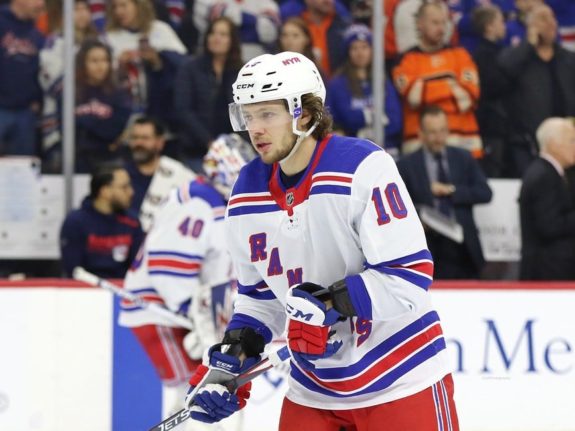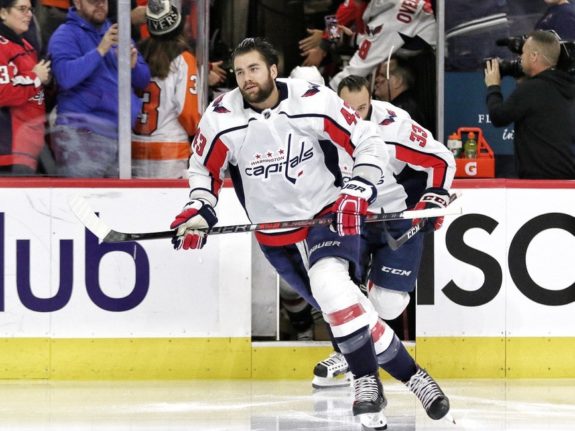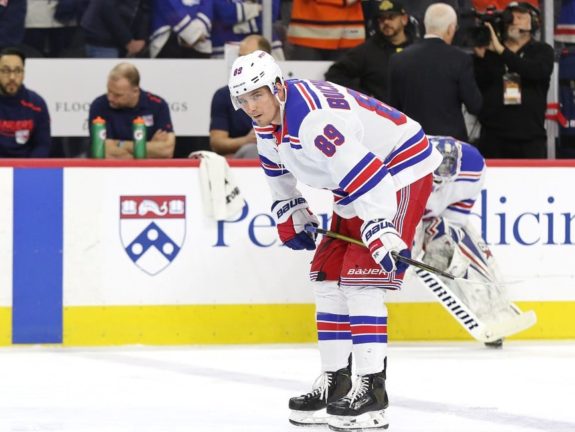The New York Rangers should be outraged and disgusted at the events of Monday night, when their biggest star and one of the NHL’s marquee players was attacked by controversial Washington Capitals’ forward Tom Wilson and was apparently put out for the season’s remaining three games with a resulting injury.
Some of their outrage and disgust over the mugging of Artemi Panarin should be directed at Wilson, one of the NHL’s dirtiest players who is enabled and validated by the Caps organization (social media staff included), as well as at the league, which in typically embarrassing fashion hit Wilson with a pocket-change fine of $5,000 and no suspension Tuesday. Yet plenty of the Blueshirts’ fury should be pointed toward the mirror.
Because this was hardly an anomaly for the Rangers – it’s just the latest chapter in a long series of situations in which the team on the ice was left with no one to deter aggression by opponents who relentlessly target the club’s stars as a formalized game plan.

The ugly lineage stretches back several years, to the end of the Black-and-Blueshirts era of franchise history. Those teams included Mike Rupp and Brandon Prust and Stu Bickel and a host of other hard-nosed players who weren’t about to allow others to push their teammates around.
That period started coming to an end in the final season under Black-and-Blueshirts creator John Tortorella in 2012-13, and eventually went away fully under successor Alain Vigneault. By the end of AV’s tenure in 2017-18, the Rangers were essentially what they are now: A team incapable of matching physical challenges by tough players who do what they please, when they please to a Blueshirts squad that has been left defenseless by management.
Rangers Stars Have Been Abused by Opponents for Years
The examples are plentiful: Rick Nash suffering a concussion on an elbow to the head by Brad Stuart of the San Jose Sharks and also being concussed by a hit from then-Boston Bruin Milan Lucic. Ryan McDonagh, at one time the Rangers’ most important player not named Henrik Lundqvist, getting abused and injured by Wayne Simmonds and Alex Burrows and even Alexander Radulov.
There’s more, and more recently: Jimmy Vesey being bloodied on a hit to the head by the Nashville Predators’ Filip Forsberg three years ago. Fast-forward to this season and first overall draft pick Alexis Lafreniere – ostensibly the Rangers’ future franchise player – scoring a goal against the New Jersey Devils on April 18 and then immediately being freight-trained into the net by defenseman Matt Tennyson, leaving Lafreniere dazed after landing hard on his shoulder. The Bruins’ season-long targeting of Ryan Lindgren and other Rangers with their big forwards.
Rangers defenseman Jacob Trouba, who has enjoyed a strong season and might be the club’s future captain, getting hammered on a check by New York Islanders tough guy Matt Martin and being forced from a game April 20 with a possible concussion (Trouba hasn’t played since). Martin elbowing top center Mika Zibanejad in the face in the first shift of Saturday’s 3-0 Blueshirts loss.
The common thread through all of these incidents? There was little or no response from the Rangers when one of their own was injured. That’s due in large part to the fact that the Rangers didn’t, and don’t, have anyone who can actually do so.
And that’s as inexplicable and inexcusable now as it was back then.
Wilson’s actions Monday were an entirely predictable occurrence. The Rangers’ long-term ignoring of this problem has shown the Caps’ intimidator/enforcer/cheap-shot artist that he, like other guys who play his type of game, can feast on Blueshirts’ utter lack of toughness with no repercussions.
One would like to believe this is the final straw, that general manager Jeff Gorton and the rest of the front office have finally learned their lesson – though that sentence could have been written about team management for quite a while now, so it’s not worth holding one’s breath. If, in fact, they have, however, the lesson is this: no one is going to protect the Rangers for you.
The Blueshirts need to forget about the laughably named NHL Department of Player Safety, which has descended into a punchline after years of turning the other cheek to this type of on-ice violence, and which essentially played a key role in the creation of Wilson, a repeat offender who knows he won’t lose significant time or money to suspension. The Rangers need to worry about this themselves.

A common phrase used to describe the club’s need to toughen up these days is “change the team’s composition.” After Monday, it’s time to dispense with that hedging language. What the Rangers need are enforcers who can stop opponents from going after the skill players they’ve spent the last three years acquiring. Period.
Rangers Should Approach Vegas Golden Knights About Ryan Reaves
This space has been used in the past to advocate for the obtaining of Vegas Golden Knights tough guy Ryan Reaves, a longtime Wilson nemesis who does to Wilson what he does to others. Reaves, perhaps the most feared fighter in the league, is signed through next season for the paltry cost of $1.75 million per year. Going to Vegas and offering to overpay for him in a trade wouldn’t normally be the best course of personnel management, but the Rangers need to do something.
Plus, depending on what the Golden Knights would want back, would it really be an overpay? The value Reaves could bring on a nightly basis would considerable, given the Rangers’ regular opponents. The hard-nosed Islanders, with Martin and giant enforcer Russ Johnston, and the Capitals, with Wilson and a big, grinding roster, are in the Blueshirts’ division. The Carolina Hurricanes, who pounded their way to a sweep of the Rangers in last season’s playoffs, return to the Metropolitan Division for 2021-22. Boston goes back to the Northeast Division after competing with the Rangers in the East Division this season, but the Blueshirts will still have to deal with them as an Eastern Conference opponent.
Incidents such as Monday’s are going to keep happening, unless the Rangers really believe the league is finally going to get tough on dangerous play and cheap shots after years of not doing so. If the Blueshirts realize instead that such an idea is fantasy, then the club has to decide if it’s finally going to deal with this internally by “changing the team’s composition.”

Because doing so is about so much more than settling scores. Continuing to leave the team utterly unable to respond in the face of rampages such as Wilson’s threatens their rebuild. Are Gorton and team president John Davidson, a man who played in the NHL during a considerably rougher era, prepared to keep watching opponents employ the same game plan of banging around and bullying the high-end youth and star players they’ve spent three years bringing in to return the team to contention?
It’s impossible to believe this doesn’t affect the team’s morale, not to mention its focus. How confidently can the Rangers take the ice against the Caps now, knowing that Wilson – who has run wild against the Blueshirts for years – can do whatever he wants to them? Is it not harder – not to mention demoralizing – to try to play hockey at the highest level knowing that your team’s skill can be negated at any time by unchecked physical play?
The unsuspended Wilson, by the way, gets another crack at it Wednesday night, when the Rangers host the Capitals again.
Toughening up Critical to Rangers’ Immediate Future
The modern, analytics-based argument that “tough guys don’t help you win” is nonsense. Reaves or another enforcer(s) would be infinitely more valuable in the lineup than yet another middling fourth-line forward. The Rangers win when Panarin and Zibanejad and eventually, Lafreniere and Kaapo Kakko and Vitali Kravtsov generate offense. That’s tough to do from the trainer’s room or the press box as they recuperate from injury.
Players like Wilson don’t help you win? The Rangers led 3-2 at the time of Monday’s second-period scrum, the Blueshirts having erased an early two-goal deficit. Washington, though, took control of the game after Wilson pulled Panarin’s hair and body-slammed him, and also punched a defenseless Pavel Buchnevich, going on to a 6-3 victory. Wilson’s antics affect the game positively for his team, and he knows it. He changed the game’s momentum, put the Rangers’ best player out for the rest of that contest and the next one against the Caps. So did not having an enforcer in the lineup really make the Rangers play better Monday night?
The Islanders regularly dress Martin and Johnston, often for the same game, when healthy (Johnston is currently on long-term injured reserve). It’s difficult to make the argument that the Isles, a Stanley Cup contender last season and this one who are built on a physical style, are negatively affected by those two players being in the lineup. In fact, they enhance the club’s approach.

Reaves played part of the 2017-18 season with the Pittsburgh Penguins, acquired largely to protect star Sidney Crosby, who said having a player like the 6-foot-1, 225-pound bruiser in the lineup made him feel safer. That should represent a pretty compelling argument for prioritizing those kinds of players in the offseason.
There’s yet another consideration for the Rangers here: the long-term health (literally and figuratively) of their product. Does the club want fans to return in greater numbers to Madison Square Garden to watch Panarin, signed for $81.5 million over seven years to star on Broadway, get beat up on a regular basis? To see Lafreniere get blind-sided? Is Adam Fox, one of the best young defensemen in the league who should receive votes for the Norris Trophy, the next Ranger with a target on his back (or perhaps, his face)? Paying customers and faithful fans have a right to be upset about this – and to demand an end to it after years of inaction.
The NHL isn’t going to be the entity that protects the Rangers’ top players (or any other players, for that matter). That’s going to have to come from within. So it would be negligent not to at least inquire about Reaves, who was injured in early April and has been out since. Wilson, the intimidator, is clearly intimidated by Reaves, who went after the Caps forward consistently during the 2018 Stanley Cup Final.
If Reaves isn’t available, there are others. Calgary Flames grinder Brett Ritchie, 6-foot-4 and 220 pounds, decisively handled Wilson in a fight four years ago and will be an unrestricted free agent in the offseason. The Hurricanes’ Jordan Martinook, a big, fiery forward who stands up for teammates with his fists, will also be a UFA and would be a great fit. San Jose Sharks tough guy Kurtis Gabriel, 6-foot-4 and 200 pounds, is also unrestricted. Would the Rangers even make another run at 44-year-old Washington defenseman Zdeno Chara, who they apparently seriously pursued as a free agent last offseason?
Whoever they choose, the Rangers need to add at least a couple of players who can stop this. It’s beyond overdue. Going into next season with another homogenous roster loaded with skill wouldn’t just be an incorrect approach, it would be an irresponsible one. Toughening up and protecting their high-end players from the Tom Wilsons of the NHL shouldn’t be optional anymore – because continuing the franchise’s upward trajectory after three years of rebuilding depends on it. Monday’s events couldn’t have made that any more clear.